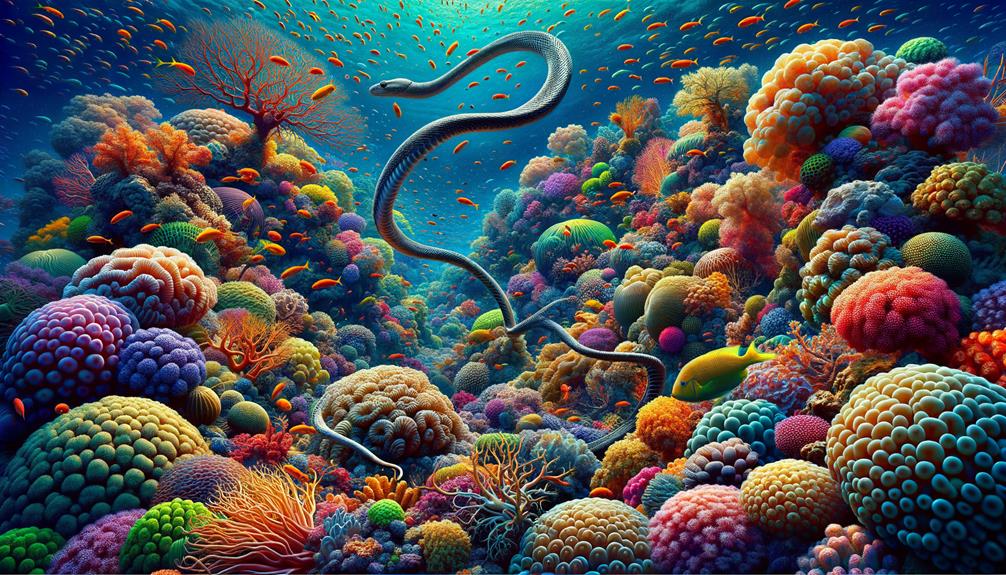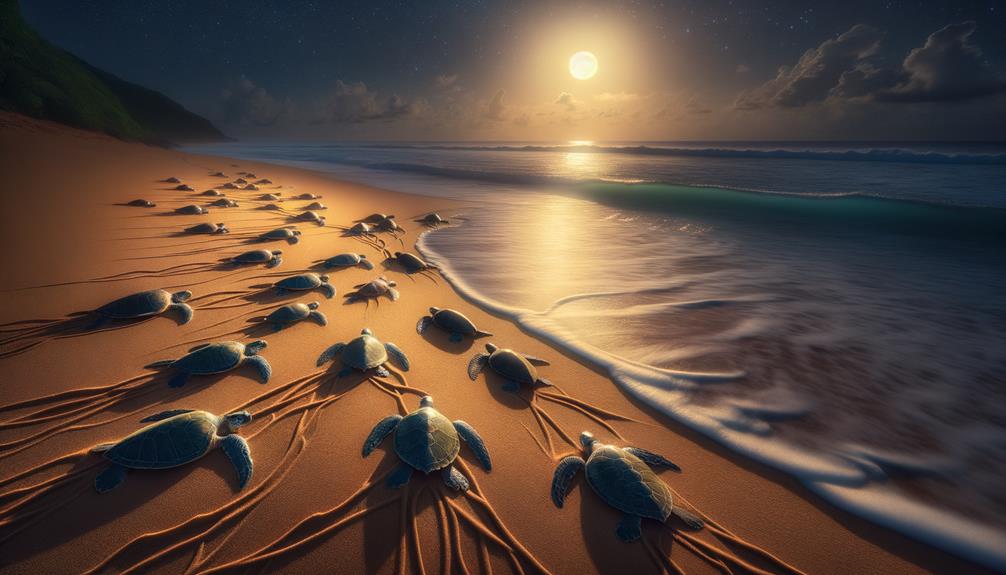Saltwater crocs, the top dogs of the mangrove world, are masters at weaving through the twisting waterways. Watching these big fellas glide silently in the murky waters, you can't help but see how they keep things in check. They hunt just enough to stop any one species from taking over, and their nests create mini-habitats for other critters. But what really gets me is how these old-timers have rolled with the punches, adapting to such a changing environment. It makes you wonder about their long history and how they'll fare as the climate shifts. These ancient beasts raise some interesting questions about survival in a world that's always on the move.
Habitat and Range
Saltwater crocodiles are masters of adaptation, thriving in diverse habitats from Australia's north to India. These top predators navigate mangrove forests and brackish channels with surprising agility. Their ability to survive in both fresh and saltwater environments showcases their remarkable resilience.
I've observed these crocodiles blend into their surroundings, whether among dense mangrove roots or in murky estuary waters. They've developed tolerance to varying salt levels, allowing them to exploit a wide range of ecosystems. This adaptability isn't just about survival; it's a testament to their evolutionary success.
In brackish channels where fresh and seawater mix, they find ample prey. Mangrove forest root systems offer perfect hiding spots. It's impressive to see how they can remain nearly invisible, waiting for the right moment to attack.
Their geographic range spans tropical and subtropical regions, making them true global citizens of the reptile world. This impressive adaptability allows saltwater crocodiles to dominate across such varied habitats.
The secret to their success lies in their ability to adjust to different environments. From coastal areas to inland waterways, these reptiles have found ways to thrive where others might struggle. Their presence across such a broad area speaks to their resourcefulness and toughness as a species.
Ecological Importance
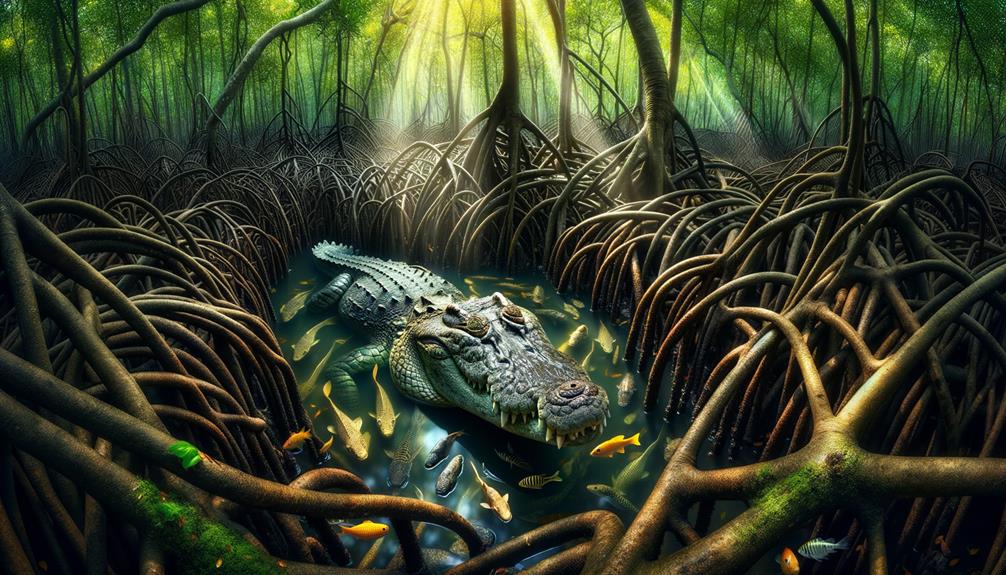
Saltwater crocodiles are key players in mangrove ecosystems, keeping fish populations in check and maintaining nature's delicate balance. These top predators hunt various fish, preventing any single species from taking over and ensuring a rich mix of aquatic life. They also serve as nature's clean-up crew, eating weak or sick fish and helping to stop diseases from spreading.
But these crocs do more than just hunt. They're also habitat shapers. Their digging and nest-building create homes for other animals, boosting the variety of life in mangroves. During dry spells, saltwater crocodiles guard water sources, keeping land animals from draining these precious reserves. This helps preserve the fragile balance of mangrove ecosystems.
Safeguarding saltwater crocodile habitats is crucial for keeping these ecosystems healthy. Clean water, thriving fish populations, and overall ecological harmony depend on their presence. By protecting these areas, we ensure the complex web of life in mangrove ecosystems stays strong and adaptable.
Predatory Behavior
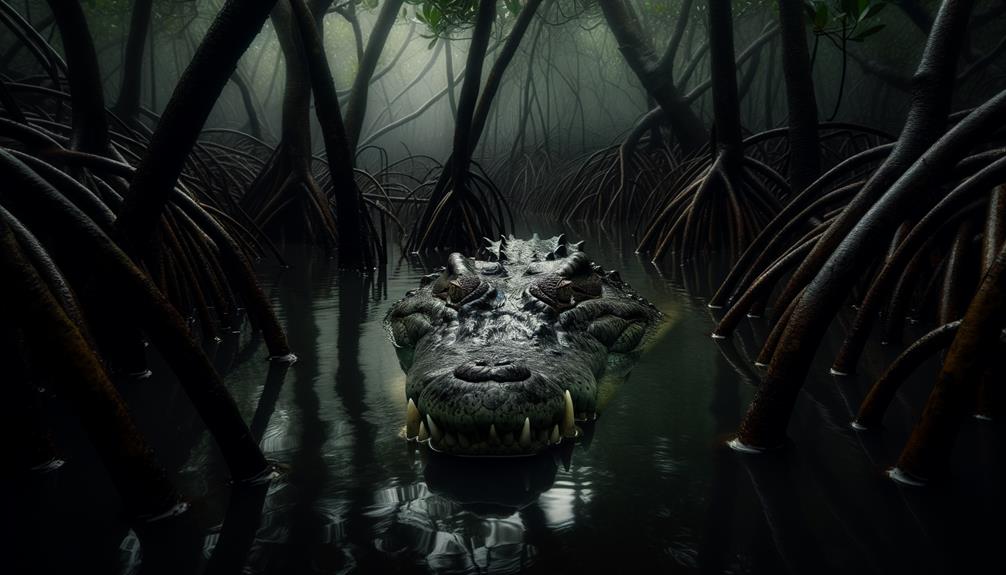
Saltwater crocodiles, or estuarine crocs, are top-tier hunters in mangrove ecosystems. These massive reptiles, reaching lengths of 6 meters and weights over 1,000 kg, are experts at lying in wait. They often stay motionless at the water's edge, ready to pounce on unsuspecting victims. Their menu is wide-ranging, including fish, birds, and even large mammals like water buffalo.
Their sheer size and power make them unrivaled in their habitat. Using a combination of brute force and stealth, they maintain their position at the top of the food chain. These crocs can handle high-salt environments, allowing them to thrive in mangroves, river mouths, and mixed saltwater areas. This adaptability expands their hunting grounds and influences the balance of these ecosystems.
A quick look at their hunting tactics:
| Strategy | Target | Habitat |
|---|---|---|
| Ambush near water | Fish, waterfowl | Mangroves, river mouths |
| Brute force attacks | Large mammals | Rivers, coastal regions |
| Salt tolerance | Various prey | Mixed saltwater areas |
These methods cement the estuarine crocodile's role as a key player in its environment.
Reproduction and Nesting
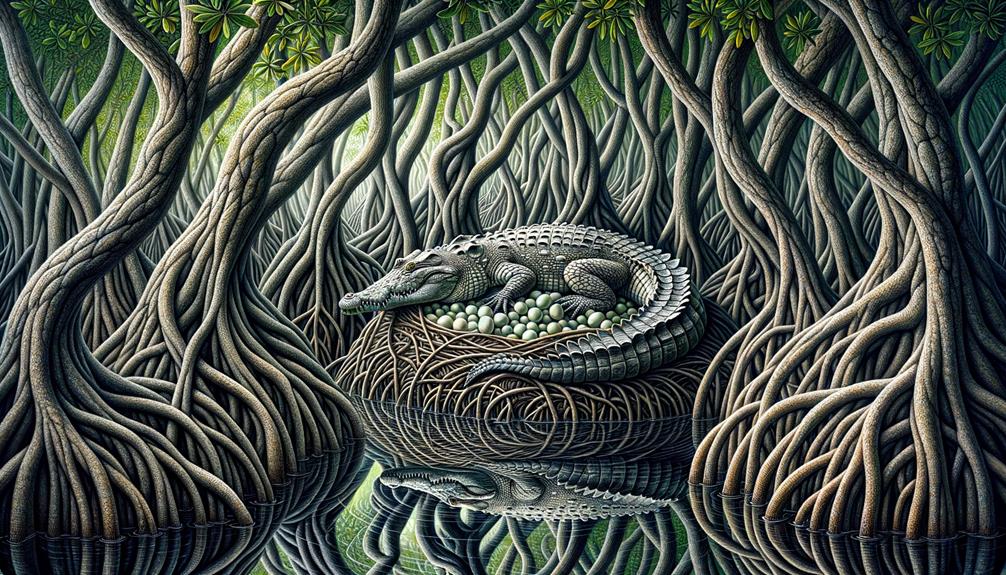
During mating season, female saltwater crocodiles show remarkable dedication to their nesting habits. These massive reptiles carefully build mound-shaped nests close to water sources, preparing for the arrival of their offspring. Each nest typically houses between 40 to 60 eggs, a sizeable brood that requires precise conditions for successful incubation.
The mother croc's work isn't done after laying her eggs. For about 80 days, she stands guard over her nest, fiercely protecting it from potential threats. This vigilance continues even after the eggs hatch, with the mother providing care and protection to her newly emerged young.
Watching this process unfold is a reminder of the intricate balance in nature. These ancient creatures, having survived for millions of years, demonstrate complex behaviors that ensure the survival of their species. The level of parental investment shown by female saltwater crocodiles is particularly noteworthy, challenging common perceptions about reptilian care for their young.
Mating Season Timing
Saltwater crocodiles begin their intricate mating rituals as the rainy season sets in. The timing varies depending on where they live, but it's always a remarkable display of nature in action. Male crocs bellow to show who's boss and catch the eye of females. Their courtship involves swimming together and gentle touching.
Watching these ancient reptiles in the wild is truly fascinating. Their instincts drive an elaborate dance of life. Males often clash violently to prove their worth, all in the name of passing on the strongest genes.
| Mating Season | Courtship Displays | Territorial Fights |
|---|---|---|
| Changes by region | Synchronized swimming | Violent confrontations |
| Loud bellows | Gentle touching | Establish pecking order |
| Rainy season | Attract females | Males face off |
After mating, females start building nests. They carefully pick spots near water. The nests are a mix of plants and dirt, forming a protective mound for their eggs. Nesting often coincides with the start of the dry season, creating ideal conditions for the eggs to develop over about 80 days. This meticulous process shows how well saltwater crocodiles have adapted to survive in their environment.
Nest Construction Habits
Female saltwater crocodiles are master builders when it comes to nesting. After their complex courtship, these reptiles get down to business, crafting impressive mounds near water sources to house their eggs. You'll often spot these structures in thick mangrove swamps, where the crocs gather plants, mud, and other organic matter to create nests up to a meter high. This clever design keeps the eggs safe from floods and temperature swings.
These nests aren't small affairs – each one typically holds between 40 and 60 eggs. The next 80 days are crucial, as the eggs develop inside the mound. During this time, mama croc doesn't take any chances. She stands guard, ready to fend off hungry predators like monitor lizards and wild pigs. Her vigilance ensures the eggs stay safe and at just the right temperature for the growing embryos.
Mangrove forests offer the perfect spot for these nurseries. The thick vegetation and nearby water create ideal conditions for hatching success. It's a testament to the saltwater crocodile's ability to adapt and their commitment to giving their offspring the best start in life.
Interaction With Other Species
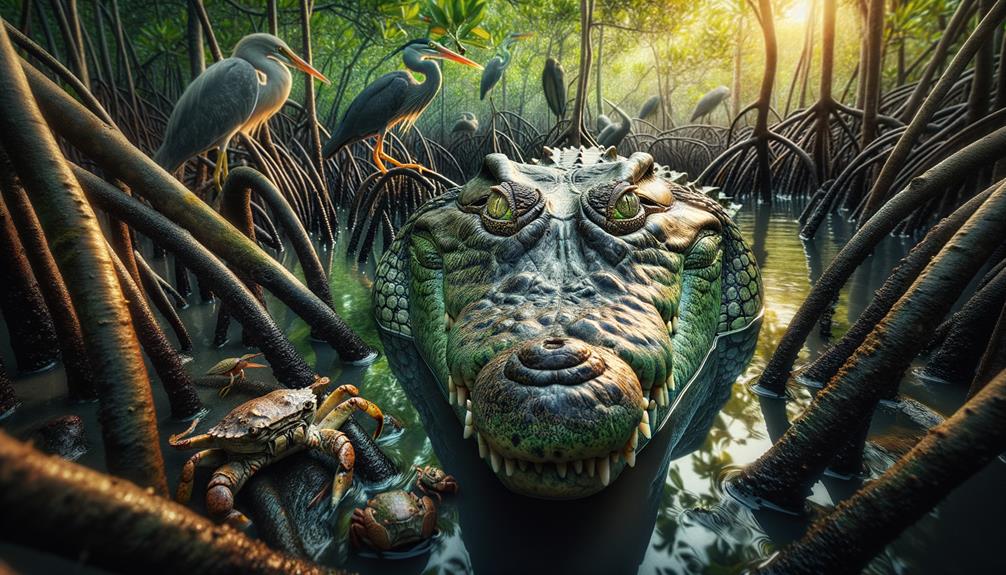
Saltwater crocodiles are key players in mangrove ecosystems, helping maintain the delicate balance of these rich habitats. As top predators, they keep animal populations in check by targeting the weak and sick. This natural selection process promotes healthier fish, bird, and mammal communities, preventing any single species from dominating.
Their nesting and digging habits also contribute significantly to biodiversity. When crocs create burrows, they unintentionally form small habitats that other creatures can use, adding complexity to the mangrove environment. This interaction benefits not just animals, but the entire forest ecosystem.
Yet, as human settlements grow, conflicts between people and crocodiles become more common. Despite these challenges, safeguarding crocodile habitats is crucial. Without these influential predators, mangrove ecosystems could face instability, with effects rippling through the entire habitat. The well-being of these ecosystems relies heavily on the presence of saltwater crocodiles.
Conservationists stress the importance of finding ways for humans and crocodiles to coexist. This might involve creating buffer zones between settlements and crocodile territories, or implementing early warning systems to alert residents of crocodile presence. Education programs can also help local communities understand the vital role these reptiles play in their environment.
As climate change threatens coastal areas, the role of saltwater crocodiles in maintaining healthy mangrove forests becomes even more critical. These ecosystems act as natural barriers against storm surges and help prevent coastal erosion. By protecting crocodile habitats, we're also safeguarding our coastlines and the communities that depend on them.
Conservation Status
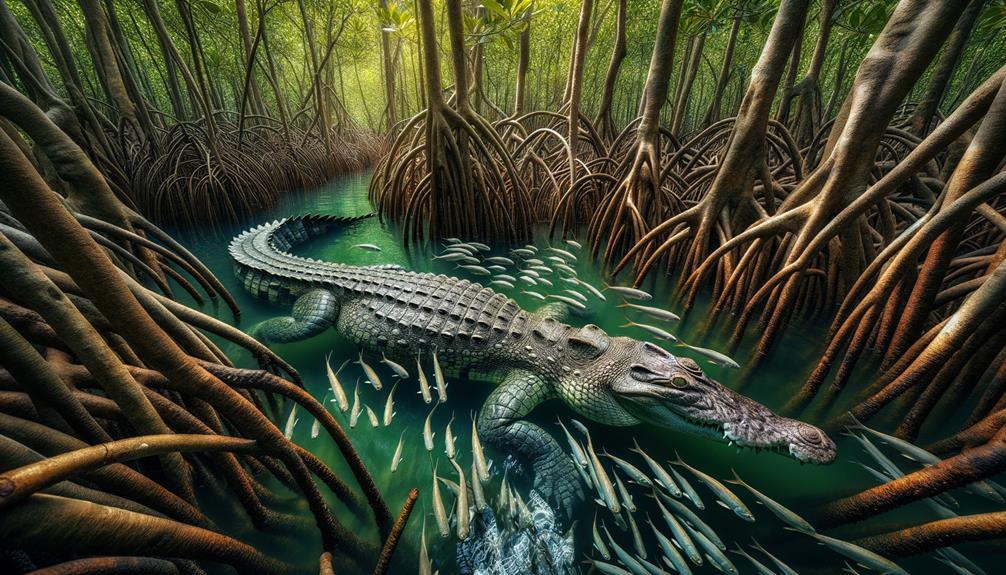
Saltwater crocodiles aren't facing immediate extinction risks, according to the IUCN's 'Least Concern' classification. This indicates their numbers are holding steady. But these reptiles aren't out of the woods yet. They're still grappling with shrinking habitats and increasing human activity in their territories. To ensure their survival, wildlife experts are working on several fronts. They're setting up protected areas, running public awareness campaigns, and finding ways for people and crocs to share space safely. These efforts are key to keeping these ancient predators around for future generations to marvel at.
Population Trends Analysis
Saltwater crocodile numbers are on the rise in several protected areas, thanks to focused conservation work. These efforts have been key to stabilizing populations, ensuring these impressive reptiles can flourish. Take Palawan, for example, where targeted programs aimed at safeguarding habitats have yielded positive results.
Let's break down the population trends in key regions:
| Region | Population Trend |
|---|---|
| Northern Australia | Increasing |
| Sundarbans | Decreasing |
| Palawan | Stabilizing |
Northern Australia has seen an uptick in saltwater crocodile numbers, thanks to tough conservation rules. The Sundarbans, however, paint a different picture. There, clashes between humans and crocs have led to a concerning drop in population. It's a stark reminder of the work that lies ahead.
In Palawan, ongoing protection efforts have helped steady crocodile numbers. This progress shows that well-planned programs can make a real difference.
Keeping tabs on these trends is crucial. It helps us gauge how well our conservation strategies are working and tweak them as needed. The end game? Making sure saltwater crocodiles thrive across their natural habitats for years to come.
Threats and Challenges
Saltwater crocodiles face an uphill battle against numerous threats, with habitat destruction and human expansion topping the list. These ancient reptiles are losing ground as cities grow and mangrove swamps shrink. The push of urban development into once-wild areas is leaving these creatures with fewer places to call home.
Illegal activities compound the problem. Poachers and unauthorized developers damage pristine environments, throwing the delicate balance of mangrove ecosystems off-kilter. As humans push further into crocodile territory, these impressive animals find themselves increasingly cornered.
Finding a middle ground between human needs and crocodile conservation is tricky. It requires careful management of resources while protecting the areas where these reptiles live. This becomes even more complicated in regions where people and crocs often cross paths. Education plays a key role here, helping communities understand how to live alongside these prehistoric predators.
Protecting habitats and getting local people involved are must-dos. Quick action is needed to reduce risks and ensure saltwater crocodiles can thrive in their natural homes. Their future depends on our shared commitment to safeguarding these vital ecosystems.
Conservation Efforts Worldwide
Worldwide efforts to protect saltwater crocodiles have gained momentum as experts recognize the urgent need to safeguard these key predators and their environments. Despite their 'Least Concern' status from the IUCN, ongoing work remains crucial to maintain the species' well-being and the broader biodiversity they support.
Conservation projects globally zero in on protecting and restoring mangrove forests, which serve as vital refuges and breeding areas for saltwater crocodiles. By preserving these habitats, we're not just helping one species, but supporting a wide range of plants and animals that share these ecosystems, boosting overall environmental health.
A significant part of these initiatives involves reducing conflicts between humans and crocodiles. Community outreach programs teach people how to coexist safely with these reptiles and underscore their role as indicators of a healthy environment.
Protecting crocodile habitats goes beyond environmental concerns; it's about maintaining the complex network of life dependent on these ecosystems. Through these united conservation efforts, we're working to ensure saltwater crocodiles continue to thrive, showcasing the positive impact of global wildlife protection measures.
Human-Crocodile Conflicts
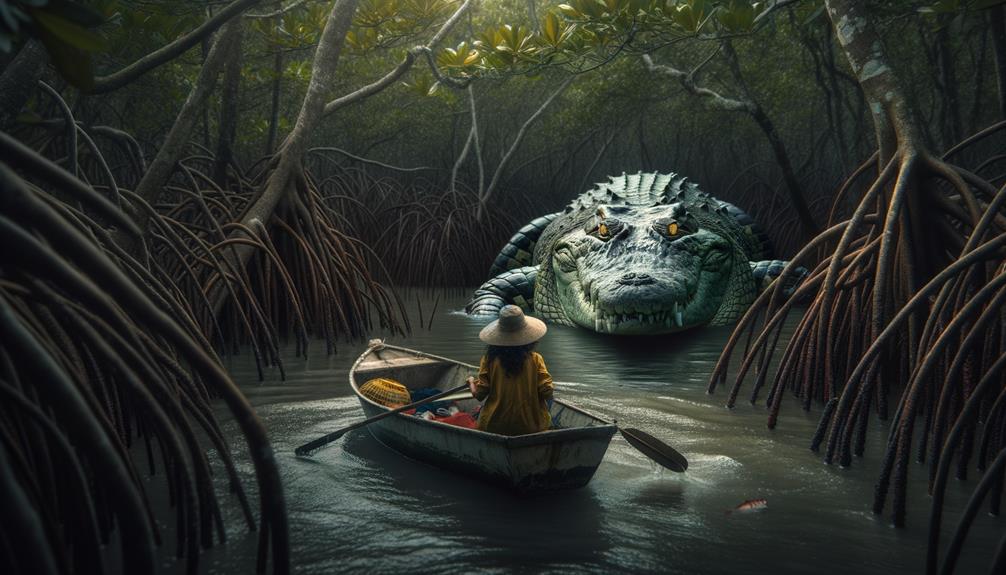
In the Sundarbans, clashes between humans and crocodiles have hit a tipping point. These fearsome reptiles now rank as the second-highest cause of deaths in the area. This situation highlights the ongoing struggle between people and wildlife. The lush mangrove forests house saltwater crocodiles, and while protecting their habitat is crucial, local communities also rely on these areas for their survival.
Fishers and honey gatherers risk their lives in these treacherous waters, often praying to Kalu Rai, the crocodile deity, for protection. Despite their respect for these creatures, the danger remains significant. Conservation groups are working hard to reduce these confrontations through community education, aiming for a safer coexistence between humans and crocodiles.
The problem is even more complex in places like Palawan, where habitat loss and human expansion have led to more frequent crocodile attacks. Knowing the difference between Philippine crocodiles and their saltwater cousins has become a matter of life and death, calling for better public education.
Finding a way to meet human needs while safeguarding crocodile habitats is a tough balancing act. As we search for answers, it's becoming clear that understanding and respecting these powerful animals is essential to reducing deaths and fostering a shared environment.
Future Outlook
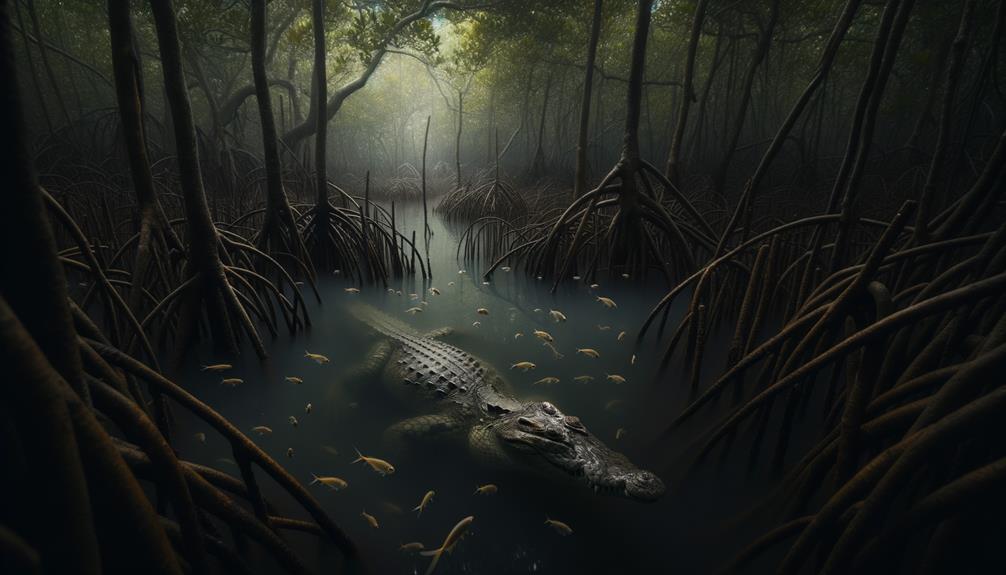
The fate of saltwater crocodiles depends on our ability to protect their habitats and educate communities about these remarkable creatures. These powerful swimmers, known for their adaptability and far-reaching travels, are under threat from shrinking habitats and human expansion. Without swift action, we risk losing a key player in our coastal ecosystems.
Preserving their future means safeguarding critical areas, especially the mangroves they inhabit. Teaching people about crocodile behavior is key to reducing conflicts and fostering respect for these ancient reptiles. Understanding their habits can help us avoid dangerous encounters and appreciate their role in nature.
It's also crucial to distinguish between different species, like the Philippine crocodile and its saltwater cousin, to implement proper safety measures. Long-term plans should aim to create a balance between local communities and these impressive predators. We need practical solutions that consider both human needs and crocodile conservation.
Ultimately, our ability to enjoy natural spaces depends on how well we protect them. By taking action now, we can ensure that future generations will still have the chance to witness these majestic creatures in their native mangrove homes.
Frequently Asked Questions
Do Saltwater Crocodiles Live in Mangroves?
Saltwater crocodiles make themselves at home in mangrove swamps. These prehistoric hunters find the perfect habitat among the twisted roots, adapting effortlessly to shifting tides and nutrient-rich mud. I've watched them nest and hunt in this complex ecosystem, their presence as natural as the ebb and flow of the water itself.
What Type of Habitat Do Saltwater Crocodiles Prefer?
Saltwater crocodiles thrive in a range of waterside environments. You'll typically spot them in mangroves, river mouths, and coastal areas where fresh and salt water mix. From my observations, these adaptable reptiles do well in various water conditions, from salty seas to freshwater rivers. They're not picky, as long as there's plenty of food around and suitable spots to lay their eggs. These crocs have a knack for finding the perfect balance between salt and fresh water, making themselves at home wherever they can find a good meal and a safe place to nest.
Are There Saltwater Crocodiles in the Sundarbans?
Yes, saltwater crocodiles call the Sundarbans home. These massive predators hide in the mangrove shadows, playing a key role in maintaining the ecosystem's balance. They're a stark reminder of nature's raw power, embodying both the wild beauty and inherent dangers of this unique habitat. Encountering one of these ancient-looking creatures might make you feel like you've stepped into a prehistoric world, but it's just another day in the complex and fascinating environment of the Sundarbans.
Are Crocs in Mangroves?
Crocodiles thrive in mangrove habitats. I've watched them navigate the thick plants and tangled roots, hunting with skill. They play a key role in these ecosystems, keeping prey numbers in check and helping cycle nutrients. It's a great example of how nature's different parts work together.


